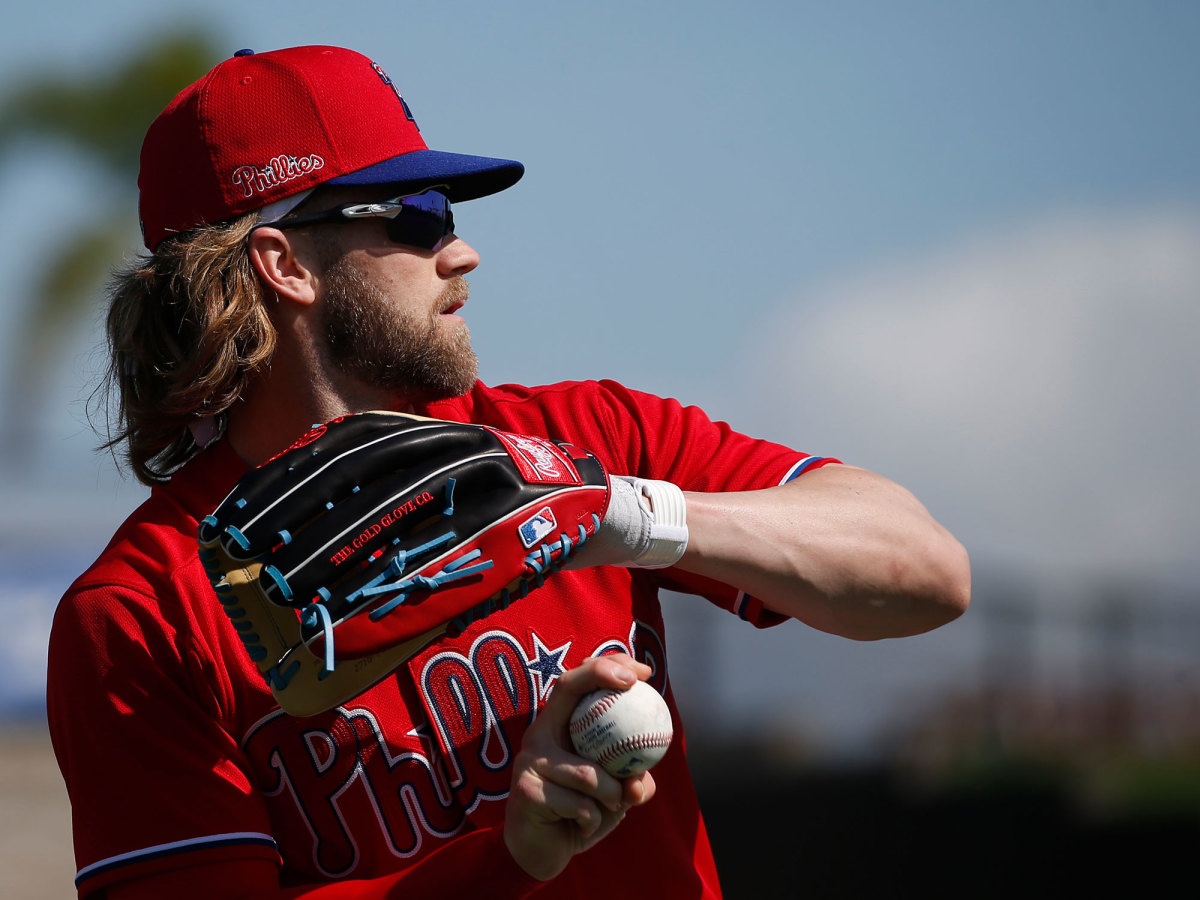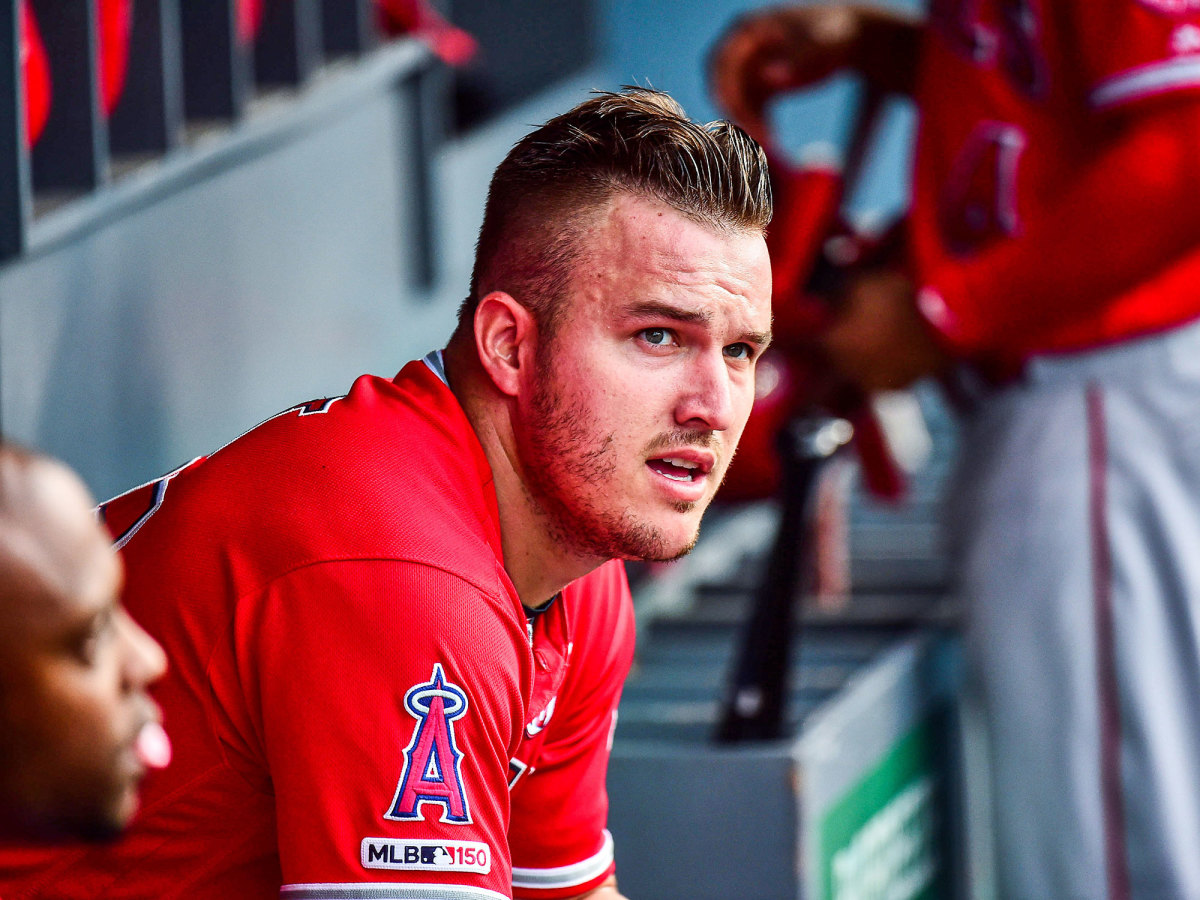Baseball’s Tragicomedy: Bryce Harper and Mike Trout Are Still Waiting for a Playoff Series Win
This is how Bryce Harper begins his 10th major league season: relearning how to throw a baseball. His ninth season ended with familiar torment—no postseason series win—and the new pain of an achy lower back every time he tried to throw.
“It was definitely a different offseason for me,” Harper says. “I took a little more time to heal and get things done that I needed to. The swing, not so much. Throwing-wise, yeah. I’ve kind of relearned how to do some things with my motion to kind of not put so much stress on a certain part of my body. It was a pretty extensive offseason to try to get through that stuff, and I’m still kind of working on that now.”

Relearning how to throw is difficult. As Harper says, “You’ve been throwing the same way your whole life.”
Winning a postseason series is even harder, especially with a defensively and bullpen-challenged Phillies team that has gone nine straight years without a winning record, the franchise’s worst drought since the Pinky Whitney and Pinky May years of 1933–48.
Go back to April 28, 2012, a planetary alignment night in baseball. Harper made his major league debut on the same night Mike Trout was promoted from the minors for the second and final time. Harper, then 19, was featured on the cover of Sports Illustrated when he was 16. Trout, then 20, was hitting .403 in the minors. It was easy to imagine the dawning of an era in which these two superstars dominated the game, drove its popularity and won multiple championships—maybe even recalling when Mickey Mantle and Willie Mays, also 19 and 20, debuted 48 days apart in 1951.
Both have lived up to the fanfare. Harper enters this season having hit more home runs through age 27 than all but 17 players in history. Trout accumulated more WAR through age 28 than all players but Ty Cobb and Rogers Hornsby. Each has been named Rookie of the Year and Most Valuable Player. They have 14 combined All-Star selections.
They also changed baseball. Before 2012, only four players in the previous 46 seasons hit 20 home runs at age 20 or younger. After Harper and Trout did it, the game tossed aside its traditional conservatism when it came to player development and began to trust its prodigies. Four 20/20 players followed them: Carlos Correa, Ronald Acuña Jr., Juan Soto and Fernando Tatis Jr.
And yet … Harper and Trout also stand out for what they have not done: win a postseason series. In that vein they are less like Mays and Mantle and more like Estragon and Vladimir meeting by a solitary tree. Such is the tragicomedy of baseball that the story of Harper and Trout, as good as they are, is the story of waiting. Winning in the playoffs is their Godot.
Baseball is the most democratic of games. Because players must bat in turn, baseball does not allow one player to influence outcomes as easily as do sports such as football, basketball, hockey and soccer. Trout is the best player in the game, but over three and a half hours he may bat only four times and touch the ball on defense once or twice.
Even with that structural limitation, however, it is highly unusual for players as dynamic as Harper and Trout to go this long without winning a postseason series, especially in an era of expanded playoffs. They are two of the four most accomplished active players yet to advance in the postseason:
Highest WAR, Never Won Postseason Series, Active Players
WAR | Postseason Series | |
|---|---|---|
Mike Trout | 74.6 | 1 |
Joey Votto | 62.1 | 4 |
Andrelton Simmons | 36.8 | 2 |
Bryce Harper | 33.7 | 4 |
The Trout drought is particularly vexing. Since expanded playoffs began in 1969, only Rod Carew (76.7) accumulated a greater WAR without winning a playoff series.
Harper lost in the first round of the postseason four times with the Nationals. Fortified by the emergence of Soto, the Nationals allowed Harper to leave for Philadelphia and a 13-year, $330 million contract. Washington immediately won the World Series. Philadelphia cannot pitch or catch well enough to be a true contender.
Harper has tried to will the Phillies into October, even with his painful back over the final five weeks of last season. Since joining Philadelphia, he has played in 215 of 220 games and been better in the clutch than every player except Freddie Freeman and Christian Yelich (as measured by win probability added).
Last year the Phillies suffered from an historically atrocious bullpen (7.06 ERA) and the worst defense in baseball (30th in defensive efficiency). The club hired Dave Dombrowski to run its baseball operations. He has tried to fix the bullpen by adding pitchers José Alvarado, Archie Bradley, Sam Coonrod and David Hale. But the poor defense is largely intact. The Phillies have the least amount of acreage to cover in their home park, but in their nine-year drought they have been consistently terrible on defense. Since 2012, their DE rankings are 21, 29, 13, 30, 23, 22, 29, 16 and 30.
“I think as a team we scored a lot of runs,” says Harper. His team ranked fourth in the league in runs per game last season. “I thought we did a great job going after it every day. We were one run away or two runs away from winning 10, 11 or 12 ballgames instead of losing those ballgames. But that’s baseball. Sometimes it doesn’t go your way.”
This season the Phillies play their first 13 games against the Braves and Mets and 22 of their first 39 against the Braves, Mets and Nationals.
“Us as an organization, I think we did the things we needed to do to get better and to do the things that get you to playoff baseball,” Harper says. “A lot of the good teams pitch well and play defense well and they run the bases well. If we can do those things and hit the ball well, I think we’ll be right where we need to be.
“This is a very, very tough division. I don’t think it will be 95 or 100 wins that wins this division, unless a team really runs away with it. We have our work cut out for us. As a team we’re looking forward to that. We’re excited about that. We’ll see in the first two or three weeks where we’re at as a team with the teams we’re playing.”
Harper is as indispensable to his team as just about any player, which is why his new throwing motion is so important. Harper grew up as a catcher and brought a similar arm stroke to the outfield when he was converted as a professional. He did not use a long, whip-like stroke common to outfielders. He raised his throwing elbow higher than his shoulder and at maximum external rotation pinched his scapula and sent stress down through his back as he rotated forward. Harper spent the winter getting his elbow and shoulder in a less stressful position during the cocking phase. This spring the Phillies have advanced slowly with Harper’s workload on defense as he continues to work through the change.
“You try to let your athleticism kick in a little bit,” he says. “It’s been good. I feel fine. I don’t really see a big difference. I don’t really think about it. I try to go out there and keep it as simple as possible and not really think about anything that I’m doing.”
To mention stress on Harper’s back early in his career might have included speculation about running into walls or the violence in his swing. Few players generate the bat speed that Harper does, and he does so with a swing renowned for its explosive effort. For years Harper hit by launching from his legs into his front side with his head and front shoulder actually rising. When he wasn’t being compared to Reggie Jackson, his statistical doppelgänger, he was being compared to Tiger Woods for the speed and violence in his swing.
The Harper swing has been tamed a bit over the years, but it is no less destructive. Hardly imaginable given the attention on him at his arrival, Harper has been undervalued as a great hitter. He always has been one of the best fastball hitters on the planet. Since 2016, Harper has the second-highest slugging percentage against fastballs (.664), second only to Aaron Judge (.679). That kind of production is all the more amazing when you consider that over the same period Harper saw the lowest rate of fastballs in the strike zone (23.1%), ahead of free-swingers Javier Báez (23.5), Rougned Odor (23.5) and Eddie Rosario (23.7). Translation: Nobody sees fewer fastballs to hit but only one hitter does more damage against them.
Harper led the league in walks last season while posting career bests in strikeout and walk rates. It is remarkable how he can wait and wait and wait as pitchers choose not to challenge him, then pounce on the rare times they do. Even though fastballs in the zone account for only 23% of the pitches he sees since 2016, they account for 56% of his home runs.
“I try to pick one spot in one zone where I can really do damage,” he says. “I’m not really scared to strike out. I’m not really scared to make a mistake or swing through a pitch. That’s why you have three of them. It’s about taking an opportunity to put the bat on the ball and good things will happen. I’m really trying to pick that one spot I can do damage with and not miss when it’s there.”

Trout turns 30 in August. Harper turns 29 in October. Both have become fathers. “It’s been so much fun,” says Harper, who has two children, Krew and Brooklyn, with his wife, Kayla. “It’s just an amazing time for me and my wife.”
The years have passed quickly. Their seasons have been bittersweet. Since that planetary alignment in 2012, Trout has never played for an Angels team that ranked in the top five in the league in ERA. Harper has played four games with a chance to advance in the postseason and lost them all in the last at bat or by one run. Their careers seem to be playing on a loop, like the days of Estragon and Vladimir spent waiting for Godot.
“And if he doesn’t come?” Estragon asks Vladimir.
“We’ll come back tomorrow.”
“And then the day after tomorrow.”
